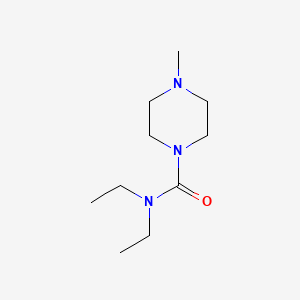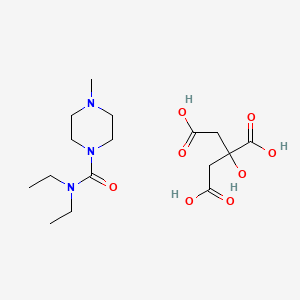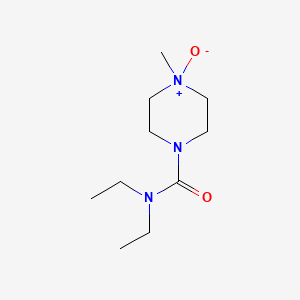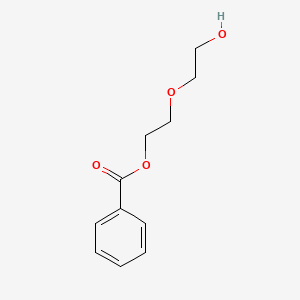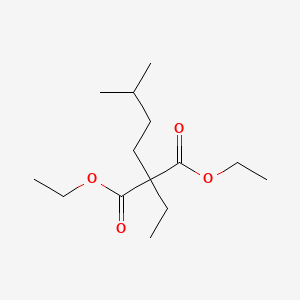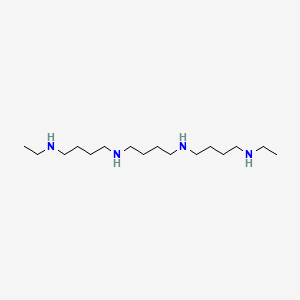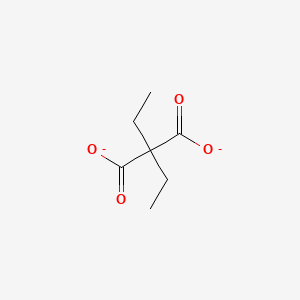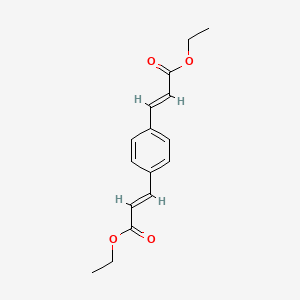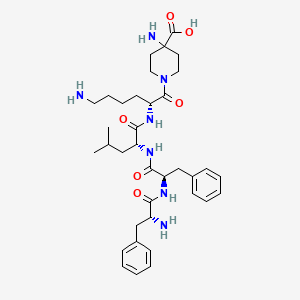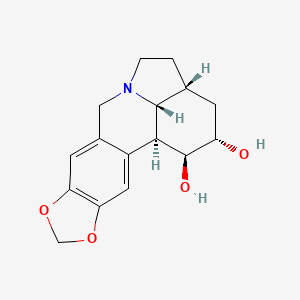
Dihidrolicorina
Descripción general
Descripción
La dihidrolicorina es un alcaloide derivado de la planta Lycoris radiata. Es un derivado de la licorina, conocida por sus diversos efectos farmacológicos. La this compound ha sido estudiada por sus posibles aplicaciones terapéuticas, particularmente en la protección cardiovascular, la neuroprotección y las actividades antitumorales .
Aplicaciones Científicas De Investigación
Protección cardiovascular: Se ha demostrado que la dihidrolicorina atenúa la fibrosis cardíaca y la disfunción al regular a la baja Runx1 después del infarto de miocardio.
Actividad antitumoral: La this compound ha demostrado una actividad antitumoral significativa en células cancerosas que muestran resistencia a los estímulos proapoptóticos.
Antiinflamatorio: Tiene efectos antiinflamatorios, lo que la hace útil en el tratamiento de diversas afecciones inflamatorias.
Mecanismo De Acción
La dihidrolicorina ejerce sus efectos a través de varios objetivos y vías moleculares:
Protección cardiovascular: Inhibe la expresión de Runx1, un gen asociado con la remodelación cardíaca adversa.
Actividad antitumoral: Inhibe la síntesis de proteínas en células eucariotas al dirigirse al paso de formación del enlace peptídico, ejerciendo así sus efectos antitumorales.
Análisis Bioquímico
Biochemical Properties
Dihydrolycorine plays a significant role in biochemical reactions by interacting with various enzymes, proteins, and other biomolecules. It has been shown to inhibit methoxamine-induced contraction of isolated rabbit aortic rings and rat anococcygeus muscle . Additionally, dihydrolycorine interacts with fibrotic genes such as collagen I, TGF β, and p-smad3, as well as apoptosis-related genes like Bax and Bcl-2 . These interactions suggest that dihydrolycorine can modulate cellular processes related to fibrosis and apoptosis.
Cellular Effects
Dihydrolycorine exerts notable effects on various cell types and cellular processes. In cardiomyocytes, it has been observed to reduce fibrosis and apoptosis, thereby improving cardiac function following myocardial infarction . Dihydrolycorine influences cell signaling pathways by downregulating Runx1, a gene associated with adverse cardiac remodeling . This regulation leads to improved cardiac contractile function and reduced cardiomyocyte hypertrophy.
Molecular Mechanism
At the molecular level, dihydrolycorine exerts its effects through several mechanisms. It binds to Runx1, inhibiting its expression and activity . This inhibition results in the downregulation of fibrotic and apoptotic genes, thereby preventing adverse cardiac remodeling. Molecular docking and binding modeling studies have identified potential dihydrolycorine-binding sites in Runx1, further elucidating its mechanism of action .
Temporal Effects in Laboratory Settings
In laboratory settings, the effects of dihydrolycorine have been studied over various time periods. It has been shown to maintain stability and efficacy in reducing cardiac fibrosis and dysfunction over extended periods . Long-term studies indicate that dihydrolycorine can sustain its therapeutic effects, with minimal degradation observed in in vitro and in vivo models .
Dosage Effects in Animal Models
The effects of dihydrolycorine vary with different dosages in animal models. At a dose of 80 mg/kg, dihydrolycorine significantly reduces mean arterial pressure in normotensive rats . Higher doses have been associated with increased efficacy in reducing infarct size and cerebral edema in a rat model of focal cerebral ischemia-reperfusion injury . Toxic or adverse effects at high doses have not been extensively reported, suggesting a favorable safety profile.
Metabolic Pathways
Dihydrolycorine is involved in several metabolic pathways, interacting with enzymes and cofactors that modulate its activity. It is metabolized in the liver, where it undergoes biotransformation to produce active metabolites . These metabolites contribute to its overall pharmacological effects, influencing metabolic flux and metabolite levels in various tissues.
Transport and Distribution
Within cells and tissues, dihydrolycorine is transported and distributed through specific transporters and binding proteins. It is known to accumulate in cardiac tissues, where it exerts its therapeutic effects . The distribution of dihydrolycorine is influenced by factors such as blood flow, tissue binding, and membrane permeability .
Subcellular Localization
Dihydrolycorine localizes to specific subcellular compartments, where it interacts with target biomolecules. It has been observed to accumulate in the cytoplasm and nucleus of cardiomyocytes, where it modulates gene expression and cellular function . The subcellular localization of dihydrolycorine is directed by targeting signals and post-translational modifications that ensure its proper distribution within the cell .
Métodos De Preparación
La dihidrolicorina se sintetiza mediante la hidrogenación de la licorina. El proceso implica la reducción de la licorina utilizando gas hidrógeno en presencia de un catalizador, típicamente paladio sobre carbono (Pd/C). Esta reacción se lleva a cabo en condiciones controladas para asegurar la reducción selectiva de los dobles enlaces en la licorina, lo que resulta en la formación de this compound .
Análisis De Reacciones Químicas
La dihidrolicorina experimenta varias reacciones químicas, que incluyen:
Oxidación: La this compound puede oxidarse para formar los óxidos correspondientes. Los agentes oxidantes comunes incluyen permanganato de potasio (KMnO₄) y peróxido de hidrógeno (H₂O₂).
Reducción: Como se mencionó, la this compound se forma a través de la reducción de la licorina. Una mayor reducción puede conducir a la formación de derivados más saturados.
Sustitución: La this compound puede sufrir reacciones de sustitución, particularmente en el átomo de nitrógeno. Los reactivos comunes para estas reacciones incluyen haluros de alquilo y cloruros de acilo.
Los principales productos formados a partir de estas reacciones dependen de las condiciones y reactivos específicos utilizados .
Comparación Con Compuestos Similares
La dihidrolicorina se compara con otros compuestos similares, como:
Licorina: El compuesto padre del que se deriva la this compound.
Pseudolicorina: Otro derivado de la licorina con propiedades farmacológicas similares.
Licoramina: Un compuesto con estructura y actividades farmacológicas similares.
Galantamina: Conocida por su uso en el tratamiento de la enfermedad de Alzheimer, comparte similitudes estructurales con la this compound.
La this compound destaca por su menor toxicidad y mejor resistencia a ciertas enfermedades, como la disentería amebiana .
Propiedades
IUPAC Name |
(1S,15R,17S,18S,19R)-5,7-dioxa-12-azapentacyclo[10.6.1.02,10.04,8.015,19]nonadeca-2,4(8),9-triene-17,18-diol | |
|---|---|---|
| Source | PubChem | |
| URL | https://pubchem.ncbi.nlm.nih.gov | |
| Description | Data deposited in or computed by PubChem | |
InChI |
InChI=1S/C16H19NO4/c18-11-3-8-1-2-17-6-9-4-12-13(21-7-20-12)5-10(9)14(15(8)17)16(11)19/h4-5,8,11,14-16,18-19H,1-3,6-7H2/t8-,11+,14+,15-,16-/m1/s1 | |
| Source | PubChem | |
| URL | https://pubchem.ncbi.nlm.nih.gov | |
| Description | Data deposited in or computed by PubChem | |
InChI Key |
VJILFEGOWCJNIK-MGRBZGILSA-N | |
| Source | PubChem | |
| URL | https://pubchem.ncbi.nlm.nih.gov | |
| Description | Data deposited in or computed by PubChem | |
Canonical SMILES |
C1CN2CC3=CC4=C(C=C3C5C2C1CC(C5O)O)OCO4 | |
| Source | PubChem | |
| URL | https://pubchem.ncbi.nlm.nih.gov | |
| Description | Data deposited in or computed by PubChem | |
Isomeric SMILES |
C1CN2CC3=CC4=C(C=C3[C@H]5[C@H]2[C@H]1C[C@@H]([C@H]5O)O)OCO4 | |
| Source | PubChem | |
| URL | https://pubchem.ncbi.nlm.nih.gov | |
| Description | Data deposited in or computed by PubChem | |
Molecular Formula |
C16H19NO4 | |
| Source | PubChem | |
| URL | https://pubchem.ncbi.nlm.nih.gov | |
| Description | Data deposited in or computed by PubChem | |
DSSTOX Substance ID |
DTXSID701346488 | |
| Record name | Dihydrolycorine | |
| Source | EPA DSSTox | |
| URL | https://comptox.epa.gov/dashboard/DTXSID701346488 | |
| Description | DSSTox provides a high quality public chemistry resource for supporting improved predictive toxicology. | |
Molecular Weight |
289.33 g/mol | |
| Source | PubChem | |
| URL | https://pubchem.ncbi.nlm.nih.gov | |
| Description | Data deposited in or computed by PubChem | |
CAS No. |
6271-21-2 | |
| Record name | Dihydrolycorine | |
| Source | ChemIDplus | |
| URL | https://pubchem.ncbi.nlm.nih.gov/substance/?source=chemidplus&sourceid=0006271212 | |
| Description | ChemIDplus is a free, web search system that provides access to the structure and nomenclature authority files used for the identification of chemical substances cited in National Library of Medicine (NLM) databases, including the TOXNET system. | |
| Record name | Dihydrolycorine | |
| Source | EPA DSSTox | |
| URL | https://comptox.epa.gov/dashboard/DTXSID701346488 | |
| Description | DSSTox provides a high quality public chemistry resource for supporting improved predictive toxicology. | |
| Record name | 6271-21-2 | |
| Source | European Chemicals Agency (ECHA) | |
| URL | https://echa.europa.eu/information-on-chemicals | |
| Description | The European Chemicals Agency (ECHA) is an agency of the European Union which is the driving force among regulatory authorities in implementing the EU's groundbreaking chemicals legislation for the benefit of human health and the environment as well as for innovation and competitiveness. | |
| Explanation | Use of the information, documents and data from the ECHA website is subject to the terms and conditions of this Legal Notice, and subject to other binding limitations provided for under applicable law, the information, documents and data made available on the ECHA website may be reproduced, distributed and/or used, totally or in part, for non-commercial purposes provided that ECHA is acknowledged as the source: "Source: European Chemicals Agency, http://echa.europa.eu/". Such acknowledgement must be included in each copy of the material. ECHA permits and encourages organisations and individuals to create links to the ECHA website under the following cumulative conditions: Links can only be made to webpages that provide a link to the Legal Notice page. | |
| Record name | DIHYDROLYCORINE | |
| Source | FDA Global Substance Registration System (GSRS) | |
| URL | https://gsrs.ncats.nih.gov/ginas/app/beta/substances/Z7N4S72301 | |
| Description | The FDA Global Substance Registration System (GSRS) enables the efficient and accurate exchange of information on what substances are in regulated products. Instead of relying on names, which vary across regulatory domains, countries, and regions, the GSRS knowledge base makes it possible for substances to be defined by standardized, scientific descriptions. | |
| Explanation | Unless otherwise noted, the contents of the FDA website (www.fda.gov), both text and graphics, are not copyrighted. They are in the public domain and may be republished, reprinted and otherwise used freely by anyone without the need to obtain permission from FDA. Credit to the U.S. Food and Drug Administration as the source is appreciated but not required. | |
Retrosynthesis Analysis
AI-Powered Synthesis Planning: Our tool employs the Template_relevance Pistachio, Template_relevance Bkms_metabolic, Template_relevance Pistachio_ringbreaker, Template_relevance Reaxys, Template_relevance Reaxys_biocatalysis model, leveraging a vast database of chemical reactions to predict feasible synthetic routes.
One-Step Synthesis Focus: Specifically designed for one-step synthesis, it provides concise and direct routes for your target compounds, streamlining the synthesis process.
Accurate Predictions: Utilizing the extensive PISTACHIO, BKMS_METABOLIC, PISTACHIO_RINGBREAKER, REAXYS, REAXYS_BIOCATALYSIS database, our tool offers high-accuracy predictions, reflecting the latest in chemical research and data.
Strategy Settings
| Precursor scoring | Relevance Heuristic |
|---|---|
| Min. plausibility | 0.01 |
| Model | Template_relevance |
| Template Set | Pistachio/Bkms_metabolic/Pistachio_ringbreaker/Reaxys/Reaxys_biocatalysis |
| Top-N result to add to graph | 6 |
Feasible Synthetic Routes
Descargo de responsabilidad e información sobre productos de investigación in vitro
Tenga en cuenta que todos los artículos e información de productos presentados en BenchChem están destinados únicamente con fines informativos. Los productos disponibles para la compra en BenchChem están diseñados específicamente para estudios in vitro, que se realizan fuera de organismos vivos. Los estudios in vitro, derivados del término latino "in vidrio", involucran experimentos realizados en entornos de laboratorio controlados utilizando células o tejidos. Es importante tener en cuenta que estos productos no se clasifican como medicamentos y no han recibido la aprobación de la FDA para la prevención, tratamiento o cura de ninguna condición médica, dolencia o enfermedad. Debemos enfatizar que cualquier forma de introducción corporal de estos productos en humanos o animales está estrictamente prohibida por ley. Es esencial adherirse a estas pautas para garantizar el cumplimiento de los estándares legales y éticos en la investigación y experimentación.


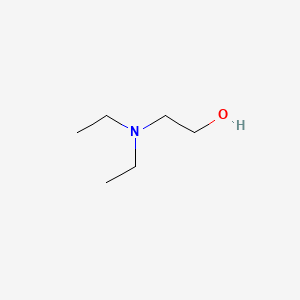
![Diethyl [2,2'-bipyridine]-5,5'-dicarboxylate](/img/structure/B1670527.png)
